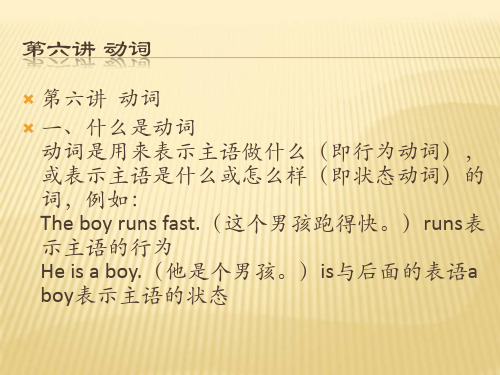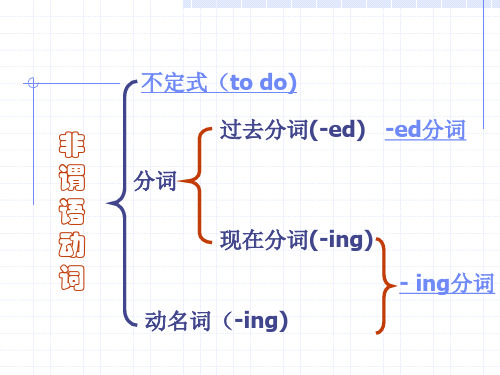专升本英语语法PPT演示文稿
专升本英语-PPT课件

先看问题,后读文章:看一题,读文章找答案; 再看第二题,再接着读文章。(一般情况下,文 章的顺序和问题的顺序一致)
抓住文章的第一段和每一段的第一句。一般文章 的第一段是提纲挈领的关键段,每一段的第一句 大多是这一段的关键句。
抓住每一句话的关键词,关键词主要是动词,尤 其是谓语动词。
I should have arrived here this morning, but the traffic is too heavy. I wonder why they’re so late. They should have been here an hour ago.
3. 情态动词表示推测的用法 1) can’t (表推测多用否定式,意为“不可能”)(对现在、将来)
条件句主句与现在事实相与过去事实相与将来事实相动词werewouldshouldcouldmight动词原形主语had动词过去分词wouldcouldshouldmighthave词过去分词if主语should动词原形if主语wereto动词原形wouldshouldcouldmight动词were精选ppt27wereyouwouldstudyenglishharder
doing (需要) The classroom building wants / needs painting. see sb. to do
doing
4. 分词 1. doing 与 done 的区别
1)时间 Don’t disturb the sleeping baby. boiling water / boiled water
Both problems are not difficult.
2. other, another, the other, others, the others another: 泛指众多中的另一个, 又一个,
专升本英语语法精品讲义ppt课件

9.It was a meeting________importance I did not realize at the time. A.which B.at which C.its D.whose 解析:定语从句修饰meeting,引导词whose在定语从句中
语法专练
1.I have seen the film,________leading actor is my
favourite. A.its B.that C.whose D.which 解析:定语从句修饰film,引导词在定语从句中作 leading actor的定语,表所属关系。 答案:C 2.The girl________everybody had thought could win a gold
的关系,whom作of的宾语。 答案:C
定语从句(二) 1.whom,which在定语从句中可作介词的宾语,这样的介词一
般放在whom,which之前也可放在原来的位置上。that也可作 介词宾语,但介词不能放在that前,只能放在原位置上;含有 介词的固定词组,介词也只能放在原位置上。 This is the nurse to whom Tom spoke just now.=This is the nurse whom Tom spoke to just now. 这就是那个Tom刚才跟她谈话的护士。 The child whom you take care of is ill.你照看的那小孩病了。
码”。后面是倒装句。 答案:C
7.I don’t like the way________he spoke to me. A.what B.by which C.by that D./ 解析:定语从句修饰way,引导词作状语时可用in which/that/不填。 答案:D
专升本语法第六章动词ppt课件

你来这儿之前学过英语吗?
d. 与否定副词not合用,构成否定句,例如:
I don‘t like him. 我不喜欢他。
e. 加强语气,例如:
Do come to the party tomorrow evening.
明天晚上一定来参加晚会。 He did know that. 他的确知道那件事。
3) 最常用的助动词有:be, have, do, shall, will, should, would
(2) 不及物动词 本身意义完整后面不须跟宾语的实义动词, 叫做不及物动词(intransitive verb)只能用于:"主+谓"结构。 如:
Birds can fly.鸟会飞。 My watch stopped.我的表停了。 She spoke at the meeting yesterday evening. 她在昨天晚上的会
11、close——be closed 12、lose——be lost
13、get to know——know 14、turn on——be on
15、get up——be up
16、sit down——sit/be seated
17、join——be in
18、become——be
(2)用it is…since…结构来替换瞬间动词,例如: 1.电影已经开映5分钟了。(两种方法)
第六讲 动词
第六讲 动词
一、什么是动词 动词是用来表示主语做什么(即行为动词), 或表示主语是什么或怎么样(即状态动词)的 词,例如: The boy runs fast.(这个男孩跑得快。)runs表 示主语的行为 He is a boy.(他是个男孩。)is与后面的表语a boy表示主语的状态
介词 专升本英语语法详细讲解课件

Apart from a few slight faults, he has done good work.除了 The orphan has no one to take care of him apart from my uncle. There were three others present at the meeting apart from Mr. Jackson.
4. 表示关于,至于的介词 In regard to, with regard to, regarding, as regards, concerning, respecting, touching, with respect to, in respect of, with reference to, in the matter of..
时间地点原因关于方法价格特性进行等介词用法要点介词和介词短语的惯用法难点企业文化就是传统氛围构成的公司文化它意味着公司的价值观诸如进取守势或是灵活这些价值观构成公司员工活力意见和行为的规范
Байду номын сангаас介词
1.分类 2. 位置 3. 介词的宾语 4. 介词的语法功能 5.时间、地点、原因、关于、方法、价格、 特性、进行等介词用法要点 6. 介词和介词短语的惯用法难点
4). Above & below (不接触,也不垂直) The plane is flying above us. The sun has sunk below the horizon. 5). Beneath=below, under, underneath
3. 表示原因或理由的介词 The old man died of liver trouble. She is sick of drinking too much. She died from hunger or poverty. He trembled for fear. The man bent with age.
SK形容词和副词专升本英语语法综述ppt课件

A. silent B.silence C. quietly D.silencely
6. They all looked __D___ at the mistakes
and felt quite _____ .
A.sad; sad
B. sadly; sadly
C. sad; sadly
D. sadly; sad
C. basically
D. especially
13. (01北京春) In that case, there is
nothing you can do __B_ than wait.
A. more B. other C. better D. any
other than 除了
14.(NMET2004全国) I don’t mind picking up
fishing forms an actual part of their leisure time.
A. accidentally
B. purposefully
C. obviously
D. formally
16.(NMET2004天津) Mr Smith used to
smoke _B__ but he has given it up.
• adv. 作状语:可以修饰动词、形容词、其他副 词、介词短语或全句。
• The room is quite small and dark. (修饰形容词) • He worked out the problem very easily.(修饰
副词) • He got on that train fortunately. • Fortunately, he got on that train. (修饰全句)
专升本英语非谓语动词ppt课件

③ 作介词/短语动词的宾语: 主语 + 谓语 + 介词+ doing
prefer…..to…..
look forward to
be used to
e.g. ①ShS.e+
put off give up
skaetepthoenre
with+oudotinsgpeaking.
②③IAlroeoykscfeouaenfculoc`tleiruhekwdeesleipandrdtotolivseinegintghherime aalognaien?.
(4) 不定式作状语
• 表示目的、原因、结果或条件 • I came here to see you. (目的) • We were very excited to hear the news. (原因) • He hurried to the school to find nobody there. (结果) • To look at him,you would like him.(条件)
不定式的时态
一、不定式的一般式 to+动词原形,所表示的动作与谓语动词的动作是同时发生的或 是在其后发生的 She was seen to enter the hall. (was seen与to enter两个动作 同时发生) I have some new to tell you. (to tell所表示的动作发生在have 之后)
2) 常跟疑问词+不定式作宾语的动词:
tell, advise, show, teach, find out, decide, discuss, learn, explain… know, show, discover, see(understand) • He taught us how to use the tool. • No one could tell me where to get the book. • I hope you’ll advise me what to do.
专升本英语语法课件

3)I have bought an umbrella. (I bought an umbrella and I have it now.) 我买了一把伞.
2.现在完成时动词可以表示开始于过去持续到现在(也许还会继续进行下去)的动作或状 态.例如:
1)I have studied English since 1975. 我从一九七五年起就学习英语. 2)They have been in Beijing since 1949. 他们从一九四九年起就(住)在北京. 3)He has lived here for two years. 他住在这儿已经两年了. 4)He has been ill for ten days.他病了十天了. 注:come, go, leave, arrive, join, die, bury, 和marry等动词所表示的动作是一时的,
(试与 I have read three books this morning 比较. ) 2)He has been staying here for two hours. 他在这儿待了两个小时了.
(试与He was here for two hours 比较.) 3)She has been living there since 1970. 她从一九七O年以来就住在这里.
式 They have not (haven’t) studied.
疑 Have I studied? Have you studied?
问 Has he studied? Have we studied?
专升本英语语法精讲课件

专升本英语语法精讲课件教学内容:本节课的教学内容选自《专升本英语语法》教材,主要涵盖第五章动词的时态和语态。
本章内容是英语语法学习的重要部分,包括一般现在时、一般过去时、一般将来时、现在进行时、过去进行时、现在完成时、过去完成时、被动语态和主动语态等。
通过本章的学习,使学生掌握动词时态和语态的用法,能够正确表达时间、动作和状态等概念。
教学目标:1. 学生能够掌握动词的时态和语态的构成和用法;2. 学生能够正确运用动词的时态和语态表达时间、动作和状态等概念;3. 学生能够通过动词的时态和语态的运用,提高英语听说读写的能力。
教学难点与重点:重点:动词的时态和语态的构成和用法。
难点:一般将来时、过去进行时、现在完成时、过去完成时和被动语态的用法。
教具与学具准备:教具:多媒体课件、黑板、粉笔。
学具:教材、练习册、笔记本。
教学过程:一、情景引入(5分钟)教师通过多媒体课件展示一些日常生活中的照片,引导学生用英语描述照片中的动作和状态,从而引出动词的时态和语态的概念。
二、知识讲解(15分钟)教师在黑板上用粉笔写出动词的时态和语态的构成和用法,一边讲解一边示例,让学生直观地理解一般现在时、一般过去时、一般将来时、现在进行时、过去进行时、现在完成时、过去完成时、被动语态和主动语态的用法。
三、例题讲解(15分钟)教师通过多媒体课件展示一些例题,让学生观察并分析例题中动词的时态和语态的用法,然后给出答案并解释原因。
四、随堂练习(15分钟)教师发放练习册,让学生完成练习题,然后教师挑选一些学生的答案进行讲评和纠正。
五、课堂小结(5分钟)六、板书设计七、作业设计1. 请用一般现在时、一般过去时、一般将来时、现在进行时、过去进行时、现在完成时、过去完成时、被动语态和主动语态各写一个句子,并解释其用法。
答案:一般现在时:I like apples.(我喜欢苹果。
)一般过去时:I visited the museum yesterday.(我昨天参观了博物馆。
强调专升本英语语法详细讲解课件.ppt

• 2. 考查“强调结构”与状语从句的辨析。 例如:
• It was evening _____we reached the little town of Winchester. A. that B. until C. since D. when
•D
• 3. 考查强调结构中的“not ... until 从 句”。例如: It was not until she got home_____ Jennifer realized she had lost her keys. A. when B. that C. where D. before
• Who was it that/who survived the plane crashes? Where was it that he picked up that book?
• 2. 特殊疑问句的强调结构用作宾语从句 时,只需把“is/was it”改为“it is/was” 即可。例如: The reporter asked who it was
强调结构
一、 强调结构的构成
• It is/was + 被强调部分 + that/who/whom + 句子的其他部分.
二、 强调结构所能强调的句子 成分
• 强调结构可以用来强调除了谓语以外的 句子成分。如果被强调的成分是主语,且 主语指人时,用that或who; 若被强调的 成分是宾语,且宾语指人时,用that或 whom; 强调其他成分时一律用that。 例 如:
B
• 4. 考查疑问句的“强调结构”作宾语。例
如:
I just wonder _____that makes him
so excited.
2024年度2024英语专升本讲座ppt全新

Maintain a positive learning attitude, cultivate selfconfidence and perseverance, and persistently prepare for exams.
03
Reasonably arrange daily routines, ensure sufficient sleep and diet, and maintain physical and mental health.
Selecting outstanding vocational students to advance to undergraduate studies
Promote communication and integration between vocational and undergraduate students
Expand learning channels by utilizing online courses, learning websites, exam preparation forums, and other online resources.
Participate in activities such as mock exams, preparation lectures, and learning exchange meetings to gain experience and skills in preparing for exams.
Test students' ability to translate English into Chinese
2024/3/23
Writing
英语专转本非谓语动词ppt课件

•She keeps buying expensive clothes.
agree to(同意) adapt to(适应) apply to(适用于) approve of(同意) be accustomed to(习惯于) be afraid of(害怕) be fond of(喜欢) be good at(擅长) be intent on(专心于) be interested in(感兴趣) be opposed to(反对的) be sick of(厌恶) be successful in(成功) be tired of(厌倦) be worried about(不开心)
动词不定式(to do)
1不定式做主语 2不定式做表语 3不定式做宾语 4不定式做宾语补足语 5不定式做定语 6不定式做状语 7不定式用法注意事项
To do that sort of thing is foolish.
Subject (主语) It is foolish to do that sort of thing.
式 )
(定语)
She came here to study English.
Adverbial (状语)
He lifted a stone only to drop it on his own feet. They jumped with joy to hear the news.
Complement The patient was warned not to eat oily food
I awoke to find my truck gone.
我醒来发现箱子不见了。
专升本一英语语法概要PPT课件

5. 表语(Predicative) 它在联系动词之后 表示主语的性质、特征、状态或身份的部分。 可有n,pron,adj,adv,num,to-do,ving,clause担任。如:
①.Susan is always careless.
②.Her job is to look after the children.
(5) What we shall do next is
not yet decided.
1. (6) Two thirds of the students
2.
are the boys in our
school.
(7) It doesn’t matter whether
he will come or not.
going to be a teacher. (5) The children ran away
它可以是一个词或是几个词或者 一个词组,或者是个句子。位置比较 灵活,可在名词前后。 1. (1)The yellow bike is mine. 2. (2) A very valuable bronze 3. Egyptian cat.
(3) The man who gave us a report yesterday was a model worker.
故,整个一句话的意思就是: 行为主义者认为, 如果儿童的 成长环境里有许多刺激因素, 这些因素又有利于其适当反应 能力的发展, 那么, 儿童的智 力就会发展到较高的水平。
1>. 主语(Subject) 它是句子的主体,是“什么 人,什么事,什么物”的问题。常由 n,pron,num,to-do,-ving,clause 担任。
一 英语语法概要
- 1、下载文档前请自行甄别文档内容的完整性,平台不提供额外的编辑、内容补充、找答案等附加服务。
- 2、"仅部分预览"的文档,不可在线预览部分如存在完整性等问题,可反馈申请退款(可完整预览的文档不适用该条件!)。
- 3、如文档侵犯您的权益,请联系客服反馈,我们会尽快为您处理(人工客服工作时间:9:00-18:30)。
extracurricular
money laundrying
7
一 构词法
dis → disappear, disagree, dislike, dishonest, discontinue, disconnect, distract
mis→ mistake, mislead, misguide, misbelief,misunderstand
mal → malfunction, malnutrition, maltreat
-ist → tourist, artist, communist, dentist
ful/less → careful,careless, useful, useless, helpful, helpless
10
-ish → selfish, foolish, bookish, childish/childlike
the last person I want to see in this city.
3
6. Her mother died of difficult labor 7. Both of them are not my brothers.
Every man cannot be a writer. All that glitters is not gold. 8. During foggy weather the trains are late more often than not. 9. You should know better than to go swimming immediately after a meal.
4
10. Only that I know you might be wanted, I should detain you a little longer
11. He is anything but a scholar. 12. You could not have made things
worse. 13. He knows no better than those
Without grammar, little can be conveyed
Without vocabulary, nothing can be conveyed.
1
Grammar
2
typical examples
1. The stranger robbed his wife. 2. He was then bright in the eye. 3. Calculation never makes a hero. 4. Do you have a family? 5. Susan is really a cat, so she is
13
四 拟声法
carnation cuckoo giggle sofa pudding coffee golf murmur crash crack meow bow-woo babble/gurgle
14
五 形象分析法
tryst eye bird
trysting place
15
六 缩略词
motel → motor and hotel telecast → television and
old methods to solve every problem.
5
14. You cannot be too cautious. 15. It never rains but it pours. 16. This is no other than the book we
want to buy. 17. James is not so much a writer as a
12
三 词尾象形归类法
1. light, right, night, flight, tight, might, sight
2. dip, kip, lip, tip, zip
lipstick, the tip of the iceberg
3. altitude, latitude, attitude, aptitude, fortitude
fore → forehead, foreground, forefather, forecast, foretell
8
pseudo →pseudoheart, pseudoscience, pseudoname
pre → preview, predict, preface, preheat, prewar, prehistory
post → postwar, postgraduate by → byproduct, bywork, bypass over → overeat, overdress, oversleep
overemphasize -ly → manly, fatherly, scholarly,
motherly
reporter. 18. She will be more than happy to
see you.
6
vocabulary
paparazzi
encyclopaedia
superstitious vivisectionist
countermeasure பைடு நூலகம்ontaminate
telecommunication pajama
11
二 造词法
make → maker → laptop-maker, car-maker, shoe-maker, watch-maker, TV-maker, law-maker,trouble-maker
-mate → deskmate, classmate, roommate, schoolmate, teammate, inmate
re → review, retell, rewrite, rearrange, reorganize, re-emphasize, recreate
il/ir → illegal, illogical, irregular, immoral, immortal
9
ex → ex-husband, ex-president, exwife
